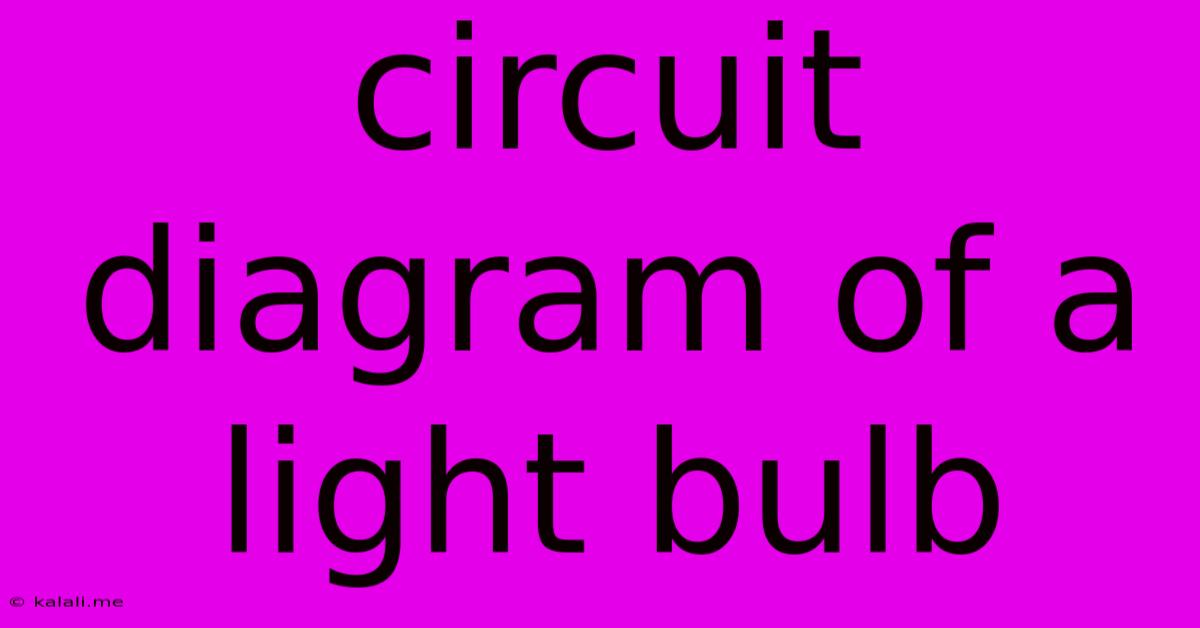Circuit Diagram Of A Light Bulb
Kalali
May 10, 2025 · 3 min read

Table of Contents
The Simple Circuit Diagram of a Light Bulb: A Beginner's Guide
A light bulb, a seemingly simple invention, relies on a surprisingly straightforward electrical circuit. Understanding this basic circuit is fundamental to grasping more complex electrical concepts. This article will delve into the circuit diagram of a light bulb, explaining its components and how they work together to produce light. This guide is perfect for beginners in electronics or anyone curious about how everyday objects function.
What is a Circuit Diagram?
A circuit diagram is a simplified visual representation of an electrical circuit. It uses standardized symbols to show the components and how they are connected, making it easier to understand the circuit's functionality without needing to see the physical wiring.
Components of a Simple Light Bulb Circuit
The simplest light bulb circuit consists of only three essential components:
-
Power Source: This provides the electrical energy needed to power the bulb. Common examples include a battery (DC power) or a wall outlet (AC power). In our diagram, we'll use a battery for simplicity.
-
Light Bulb: This is the load in the circuit, converting electrical energy into light and heat. The filament inside the bulb is a crucial element, offering resistance to the flow of electricity, causing it to heat up and glow.
-
Wires: These provide the pathway for the electric current to flow between the power source and the light bulb. They must be conductive materials, such as copper.
The Circuit Diagram
The circuit diagram for a light bulb is exceptionally simple. It's typically depicted as follows:
+----[Battery]----+
| |
| |
+----[Bulb]---+
- Battery: The long line represents the positive terminal (+) and the short line represents the negative terminal (-).
- Bulb: The circle with a squiggly line inside represents the light bulb filament, showing the resistive element.
- Wires: The straight lines connecting the battery and the bulb represent the conductive wires.
How the Circuit Works
When the circuit is complete (meaning the switch is closed, allowing current to flow), the electrons flow from the negative terminal of the battery, through the wire, into the filament of the light bulb. The filament's resistance converts this electrical energy into heat and light. The electrons then continue flowing through the wire back to the positive terminal of the battery, completing the circuit. The flow of electrons continues as long as the circuit remains closed. This continuous flow of electrons is what we call electric current.
Understanding Voltage, Current, and Resistance (Ohm's Law)
The relationship between voltage, current, and resistance in this simple circuit is governed by Ohm's Law: V = IR.
- V (Voltage): The electrical potential difference between the battery terminals, measured in Volts (V).
- I (Current): The flow of electrons, measured in Amperes (A).
- R (Resistance): The opposition to the flow of current, primarily from the light bulb filament, measured in Ohms (Ω).
This formula indicates that a higher voltage will lead to a higher current, provided resistance remains constant. Conversely, a higher resistance will reduce the current for a given voltage.
Beyond the Basic Circuit
While this illustrates the fundamental principle, real-world light bulb circuits often incorporate additional components like switches for control and fuses or circuit breakers for safety. These additions make the circuit diagrams more complex, but the core principle of a complete path for current to flow remains the same. Exploring these more complex circuits builds upon the foundational understanding presented here.
This simple explanation, coupled with the visual circuit diagram, should provide a clear understanding of how a light bulb works electrically. Remember, mastering this fundamental concept is a crucial first step in exploring the exciting world of electronics.
Latest Posts
Latest Posts
-
What Fraction Is Equivalent To 1 2
Jul 13, 2025
-
What Is The Average Iq For A 9 Year Old
Jul 13, 2025
-
How Long Does It Take For Brandy Melville To Ship
Jul 13, 2025
-
How Many Times Does 3 Go Into 30
Jul 13, 2025
-
In What Episode Of Bleach Does Ichigo Ask Orihime Out
Jul 13, 2025
Related Post
Thank you for visiting our website which covers about Circuit Diagram Of A Light Bulb . We hope the information provided has been useful to you. Feel free to contact us if you have any questions or need further assistance. See you next time and don't miss to bookmark.